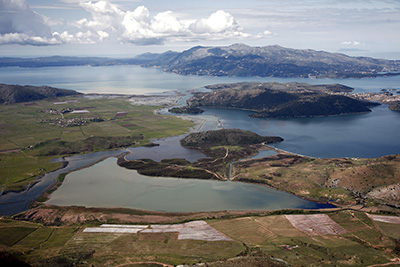Butrint (Albania)
Butrint Project

Archaeological mission coordinator/director
Enrico Giorgi (DiSCi - University of Bologna); Belisa Muka (Archaeological Institute of Tirana)
Research Area and ERC Panels
- Archaeology from pre and proto history to medieval age
- SH6 The Study of the Human Past: Archaeology and history (3rd level 12)
Activation date of the campaign and duration
The Albanian and Italian archaeological research project in Butrint was born in 2015 within the broader agreement with the Archaeological Institute of Tirana, in place since 2000. Since 2017 the Butrint project is an Archaeological Mission supported by the Ministry of Foreign Affairs and International Cooperation of the Italian Republic. The project has since been involved with annual research campaigns, of variable duration, with the presence of Italian and Albanian students in the field.
Overview
The city of Butrint was born in the ancient region of Caonia, part of northern Epirus. The site develops on the terminal part of the Ksamil peninsula, surrounded by the lake of Butrint and by the Vivari channel, which separates the promontory from the near Vrina plain. The center was born in a particularly favourable position, which allows for a long phase of occupation, from the Bronze Age to the late 16th century. Butrint experiences one of its moments of greatest growth during the Hellenistic age, while it frees itself from the control of the overlooking island of Corfu to become the administrative center of the Chaonians koinon. Between 3rd and 2nd century BC there is the construction of some of the most representative buildings in the city, such as the theatre and the gate of Asclepius in order to widen the Sanctuary, as well as the extension of the wall circuit. The deduction as a Roman colony with the name of Augusta Buthrotum, immediately after the battle of Actium, represents another moment of particular growth, also thanks to the expansion of the inhabited center on the nearby Vrina plain between the 1st century BC. and the 2nd century AD. In late antiquity, Butrint experienced a new phase of growth linked in particular to the Christian presence, of which are examples the Basilica on the Acropolis, the Baptistery and the Triconch Palace. From the 6th century AD it becomes an important military base, also testified by the expansion of the wall circuit between the 10th and 11th century, seat of the Byzantine fleet. The last phase of life sees the domination of the Venetian Republic between the 13th and 14th centuries, with the progressive abandonment of the ancient city.
The Project consists in the excavation of the Acropolis and the Walls, in the study and topographic documentation with Laser Scanner and Drone of the main monuments of the Archaeological Park of Butrint, also for monitoring and mapping of the state of conservation. The archaeological excavation is currently underway in the Acropolis area and is set up as a school camp for Albanian and Italian students of archeology. The research fields of the Project are the following:
- Excavation of the Acropolis and the Walls
- Study, topographical and photogrammetric survey, analysis of the state of conservation and degradation of the wall circuit
- Study of the Hellenistic and Roman necropolis of the city
- Study of the occupation phases of the Acropolis
- Study of material culture
- Surveys on the territory, with particular attention to the fortified offshore sites
Information for the students
Excavation is allowed only for students with a certificate of attendance of courses on safety in archaeological sites and a certificate of suitability for the role of archaeologist (with medical examination). Participants are guaranteed travel, food and accommodation.